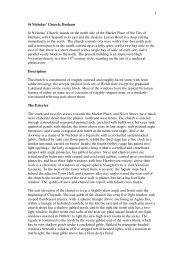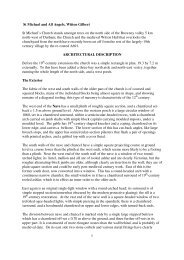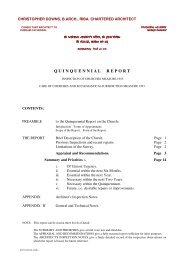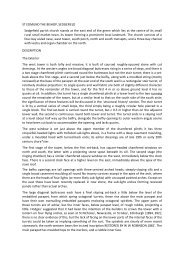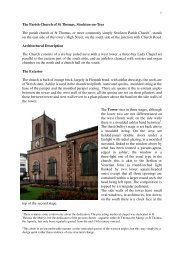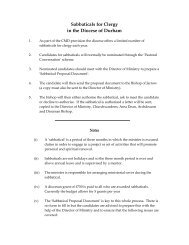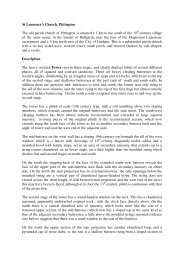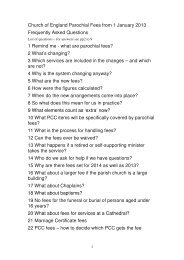St John the Evangelist, Kirk Merrington The parish church of Kirk ...
St John the Evangelist, Kirk Merrington The parish church of Kirk ...
St John the Evangelist, Kirk Merrington The parish church of Kirk ...
You also want an ePaper? Increase the reach of your titles
YUMPU automatically turns print PDFs into web optimized ePapers that Google loves.
enewed in <strong>the</strong> 14 th or 15 th century. At some late medieval or post-medieval date <strong>the</strong> original<br />
high-pitched ro<strong>of</strong> <strong>of</strong> <strong>the</strong> western nave was replaced by <strong>the</strong> low leaded one shown by Billings;<br />
<strong>the</strong> elaborate tower parapet shown in <strong>the</strong> same print looks like a 17 th or 18 th century<br />
reconstruction <strong>of</strong> <strong>the</strong> original; both <strong>the</strong> antiquarian accounts and <strong>the</strong> print make it clear that<br />
<strong>the</strong>re had been various alterations to <strong>the</strong> fenestration <strong>of</strong> <strong>the</strong> <strong>church</strong>.<br />
<strong>The</strong> Restoration that became a Rebuilding: <strong>the</strong> ‘Galvanised Corpse’<br />
<strong>The</strong>n came Pickering’s 1850/1 rebuilding, and much subsequent beating <strong>of</strong> antiquarian<br />
breasts. Hodgson (1912, 209-11), diverted (as <strong>of</strong>ten) within an article on Durham <strong>church</strong><br />
fonts, talks <strong>of</strong> <strong>the</strong> <strong>church</strong> abandoned to <strong>the</strong> ‘wreckers’ and that, ‘when <strong>the</strong> work <strong>of</strong> demolition<br />
finished, that <strong>of</strong> confusion and mystification began’. He states that <strong>the</strong> facing stones <strong>of</strong><br />
chancel and tower were re-used in <strong>the</strong>ir wea<strong>the</strong>red state, but that inside, old dressings were retooled<br />
so that ‘all looks coldly, hardly, brightly, painfully new without really being so. Its is<br />
like looking upon a galvanised corpse’.<br />
Two major questions remain. How closely does Pickering’s rebuilding replicate <strong>the</strong> old<br />
<strong>church</strong>, and does anything <strong>of</strong> <strong>the</strong> medieval fabric survive?<br />
As Hodgson stated, <strong>Kirk</strong> <strong>Merrington</strong> <strong>church</strong> in its present state is a difficult building to<br />
interpret. On close inspection, <strong>the</strong> building, with its variations in fabric, and in architectural<br />
detail, looks anything but <strong>the</strong> product <strong>of</strong> a single rebuilding. <strong>The</strong> variations in form between<br />
<strong>the</strong> various windows might suggest that <strong>the</strong> architect was carefully copying what was <strong>the</strong>re<br />
before, but inside <strong>the</strong> two tower arches are now identical whereas antiquarian accounts make<br />
it clear that <strong>the</strong>y formerly had jambs <strong>of</strong> quite different form.<br />
<strong>The</strong> vertical patches <strong>of</strong> better-squared stone in <strong>the</strong> lower part <strong>of</strong> <strong>the</strong> tower are especially<br />
puzzling. <strong>The</strong> plinth that runs below <strong>the</strong>m is clearly 19 th century, and that at <strong>the</strong> south-west<br />
corner shows no sign <strong>of</strong> <strong>the</strong> straight joint shown by Billings. So are <strong>the</strong>y a quirk <strong>of</strong><br />
Pickering’s rebuilding, perhaps introduced to better tie toge<strong>the</strong>r <strong>the</strong> walls <strong>of</strong> tower and nave?<br />
Hodgson’s fulminations against <strong>the</strong> rebuilding (admittedly written almost half a century<br />
afterwards) suggest that tower was rebuilt from <strong>the</strong> ground. However, <strong>the</strong> evidence <strong>of</strong> <strong>the</strong> ‘Lshaped<br />
blocks’ at <strong>the</strong> junction between <strong>the</strong> better-squared stonework and <strong>the</strong> adjacent more<br />
rubbly masonry probably tilts <strong>the</strong> balance in favour <strong>of</strong> seeing <strong>the</strong>se areas <strong>of</strong> walling as an insitu<br />
survival <strong>of</strong> <strong>the</strong> 12 th -century tower, although <strong>the</strong> character <strong>of</strong> <strong>the</strong> stonework (unlike that reused<br />
in <strong>the</strong> chancel) is not distinctive <strong>of</strong> this period. <strong>The</strong> large elongate blocks might be more<br />
happily placed in a Saxo-Norman overlap context than a fully Norman one.<br />
Inside <strong>the</strong> tower, <strong>the</strong> big set-back a little above <strong>the</strong> floor <strong>of</strong> <strong>the</strong> middle stage chamber could<br />
conceivably mark <strong>the</strong> top <strong>of</strong> surviving unrebuilt fabric, although it is very regular, and might<br />
simply be a 19 th -century constructional feature.<br />
Turning to <strong>the</strong> chancel, Fordyce explicitly states that ‘a portion <strong>of</strong> <strong>the</strong> north wall’ (which<br />
presumably means that <strong>of</strong> <strong>the</strong> chancel) was spared simply because it had already been<br />
‘restored’ a few years before. As already described, <strong>the</strong> wall contains several problematical<br />
features; again, <strong>the</strong> balance <strong>of</strong> evidence would seem to favour a pre-19th century (and<br />
presumably medieval) date, but it is difficult to say much more than this. <strong>The</strong> traces <strong>of</strong> a<br />
blocked doorway might indicate that <strong>the</strong>re was formerly a vestry here.<br />
<strong>The</strong> whole chancel is something <strong>of</strong> a puzzle, both in its careful re-use <strong>of</strong> wea<strong>the</strong>red old<br />
11




